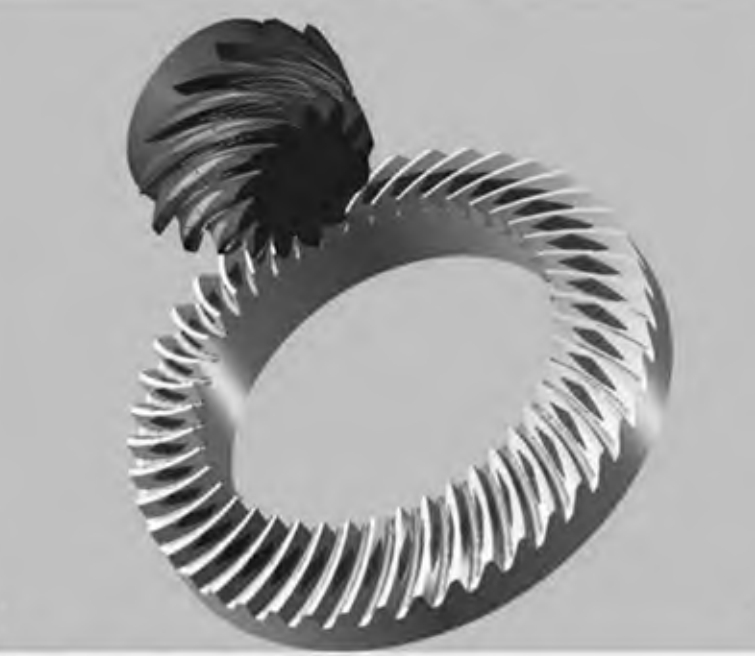Abstract:
To predict the dry running time of spiral bevel gears, a coupling prediction method integrating tooth surface elastohydrodynamic lubrication (EHL), tooth meshing, and gear system heat transfer is proposed. This method aims to reveal the evolution mechanism between micro-EHL and macro flow field/temperature field.

1. Introduction
In special situations such as helicopters encountering severe weather or being hit by bullets, the lubrication system of the transmission system may be damaged, leading to oil leakage. During the oil loss process, the lubrication state of the gears deteriorates, and friction heat generation on the tooth surface increases. Simultaneously, the reduction in heat carried away by the lubricating oil causes a sharp rise in temperature in the gear meshing area. This thermal deformation results in reduced tooth side clearance, gradual reduction, and eventual rupture of the oil film between tooth surfaces, leading to conditions such as gear scuffing. To ensure safe return after oil loss, helicopter transmission systems are designed to have a dry running capability of at least 30 minutes, with advanced models requiring even more than 60 minutes. This poses high requirements for the dry running capability of spiral bevel gears located in the high-speed end of the main reducer and the tail reducer.
2. Multi-dimensional Coupling Prediction Method
To reveal the transient evolution mechanism of complex objects from both micro and macro perspectives, a multi-dimensional lubrication characteristic prediction method for spiral bevel gears is established, incorporating three dimensions: tooth surface EHL, tooth meshing, and gear system heat transfer, combined with time and spatial scales.
Table 1: Time and Spatial Scales of Different Dimensions
| Dimension | Time Scale | Spatial Scale |
|---|---|---|
| Tooth Surface EHL | O(10-6) s | O(10-6) m |
| Tooth Meshing | O(10-4) s | O(10-4) m |
| Gear System Heat Transfer | O(10-1) s | O(10-1) m |
2.1 Tooth Surface EHL Dimension
A steady-state thermal EHL model for spiral bevel gears is established using EHL theory to calculate the oil film thickness and friction coefficient in the micro-contact area of the tooth surface. This provides a time-varying friction heat source for the tooth meshing dimension and the gear system heat transfer dimension.
2.2 Tooth Meshing Dimension
CFD methods are used to simulate and calculate gear windage power loss, convective heat transfer coefficient of tooth surfaces, and temperature field distribution of individual gears. The friction heat source and windage power loss in the tooth meshing dimension are the heat sources for the gear system heat transfer dimension.
2.3 Gear System Heat Transfer Dimension
CFD methods are applied to calculate the convective heat transfer coefficient and temperature field distribution within the system. The fluid temperature inside the gearbox is the ambient temperature for CFD simulation of the tooth meshing dimension and the initial oil temperature for numerical calculation in the tooth surface EHL dimension.
3. Time-Varying Friction Coefficient Under Oil Loss
During oil loss, the time-varying friction coefficient of spiral bevel gears is calculated based on the oil film retention parameter and other relevant parameters.
4. Simulation Results and Analysis
Table 2: Temperature Variation of Gear Components Over Time
| Time (s) | Large Gear Temperature (°C) | Small Gear Temperature (°C) |
|---|---|---|
| 600 | 95 | 108 |
| 1200 | 122 | 141 |
| 1800 | 152 | 176 |
| 2400 | 180 | 209 |
| 3000 | 205 | 239 |
| 3600 | 227 | 266 |
| 4200 | 246 | 289 |
| 4800 | 263 | 309 |
5. Conclusion
This paper proposes a multi-dimensional coupling prediction method for the dry running time of spiral bevel gears in helicopter transmission backgrounds, integrating tooth surface micro-thermal EHL characteristics, time-varying friction coefficients during oil loss, and macro-scale flow field/temperature field simulation calculations. The main conclusions are as follows:
- By combining tooth surface load contact theory, EHL theory, and CFD simulation analysis, a multi-dimensional coupling prediction method integrating tooth surface EHL, tooth meshing, and gear system heat transfer is established. This reveals the transient evolution mechanism between micro-EHL and macro flow field/temperature field during oil loss.
- Through multi-dimensional dry running simulations of spiral bevel gears, it is predicted that the gears will fail in approximately 1.5 hours.
